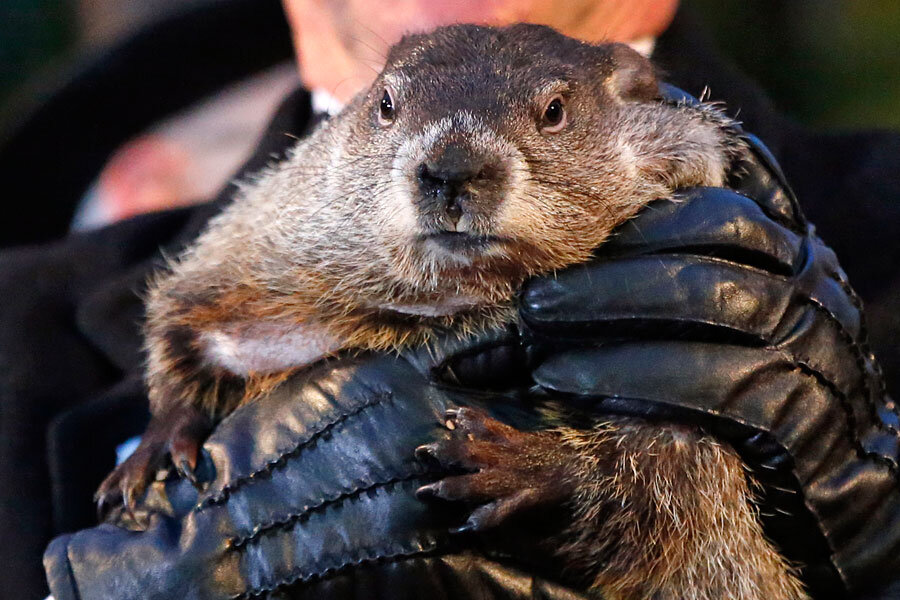Are the computer models any better than Punxsutawney Phil?
Loading...
Who’s more accurate, a lab full of scientists with supercomputers performing predictive ensemble calculations or a large ground squirrel?
Some say that the failure to accurately predict Superstorm Sandy and even last week’s winter storm have led the public to have more faith in a rodent than a supercomputer.
“It’s the whole ‘cry wolf’ issue where you lose credibility each time you say New York’s going to get three feet or more of snow and they get 10-inches instead,” says Clifford Mass, an atmospheric scientist at the University of Washington. “Forecasting has come along huge strides in the past 50 years. That’s not an issue. But it ain’t perfect!”
He points to the way US forecasts for Superstorm Sandy lagged behind European modeling due to a lack of computer power and accuracy.
“We failed to get that right because America couldn’t afford to buy a better computer,” Dr. Mass says. “That’s a big part of what’s driving Republican enthusiasm for dropping climate change in favor of weather forecasting.”
Mass is an advocate of infusing millions into what he terms “probabilistic ensemble prediction” which basically means using lots of data sources run multiple times through supercomputers to improve forecasting.
On another front are the supporters of more traditional forecasting methods.
“I think we do a great job,” says Pete Geiger, owner and editor of The Farmers' Almanac in a phone interview from his office in Lewiston, Maine, where he says he knew two years ago the weather today would reach a stormy sub-zero.
The Farmers' Almanac – which is a rival publication to the similarly named Old Farmer's Almanac – uses a "secret mathematical and astronomical formula" created in the 1800s by a former editor, which takes into account sunspots, the position of the Earth, the effects of the moon, and some good old-fashioned know-how by a prognosticator who goes by the pseudonym Caleb Weatherbee to predict the weather two years in advance, Mr. Geiger explains.
Several million copies per year of the Almanac circulate in the United States, according to Geiger.
“Last winter the whole winter went exactly as we predicted it to go,” Geiger says. “Our forecasting is a bride’s best friend because where else can you go more than a year-out to get a forecast that-s 80-85 percent accurate?”
Geiger sadly admits to one, singular, epic fail of his magazine’s predictive system: Superstorm Sandy.
“We missed Sandy. But then again, so did the they guys at NOAA and the National Weather Service that people want to hand $360 million,” Geiger asks. “Tell me, how much better are you going to get for that money when we’re neck-and-neck with them using a system from the 1800s?”
“Don’t listen to those Farmers' Almanac people,” says Mass who, through his blog, is a vocal critic of the NOAA (National Oceanic and Atmospheric Administration), the Farmers' Almanac, the Old Farmer's Almanac, the groundhog, and many other weather predictors. “The Almanac involves no skill whatsoever. It’s like the groundhog, a fun and folkloric bit of fun and games.”
Mass says he has also contributed his opinion to members of the House of Representatives in support of their quest to infuse $360 million into NOAA between 2015-2017 – if it passes through the Senate and is signed into law by the President.
“The Republicans are behind weather forecasting instead of climate change because a lot of red states are negatively impacted by severe weather events,” Mass says. “Weather forecasting becomes political fast. It becomes technical fast. It’s no accident that we had the announcement that new supercomputers are coming in September (2015) the moment we got a Republican-controlled Congress.”
Mass adds, “We [Americans] invented numerical weather prediction and fell to third in the world because we couldn’t buy what we needed. It came down to a lack of computing power.”
Meanwhile, in Maine, Caleb Weatherbee and his six predecessors over the past 198 years started with a chalk slate and have graduated to using calculators.








